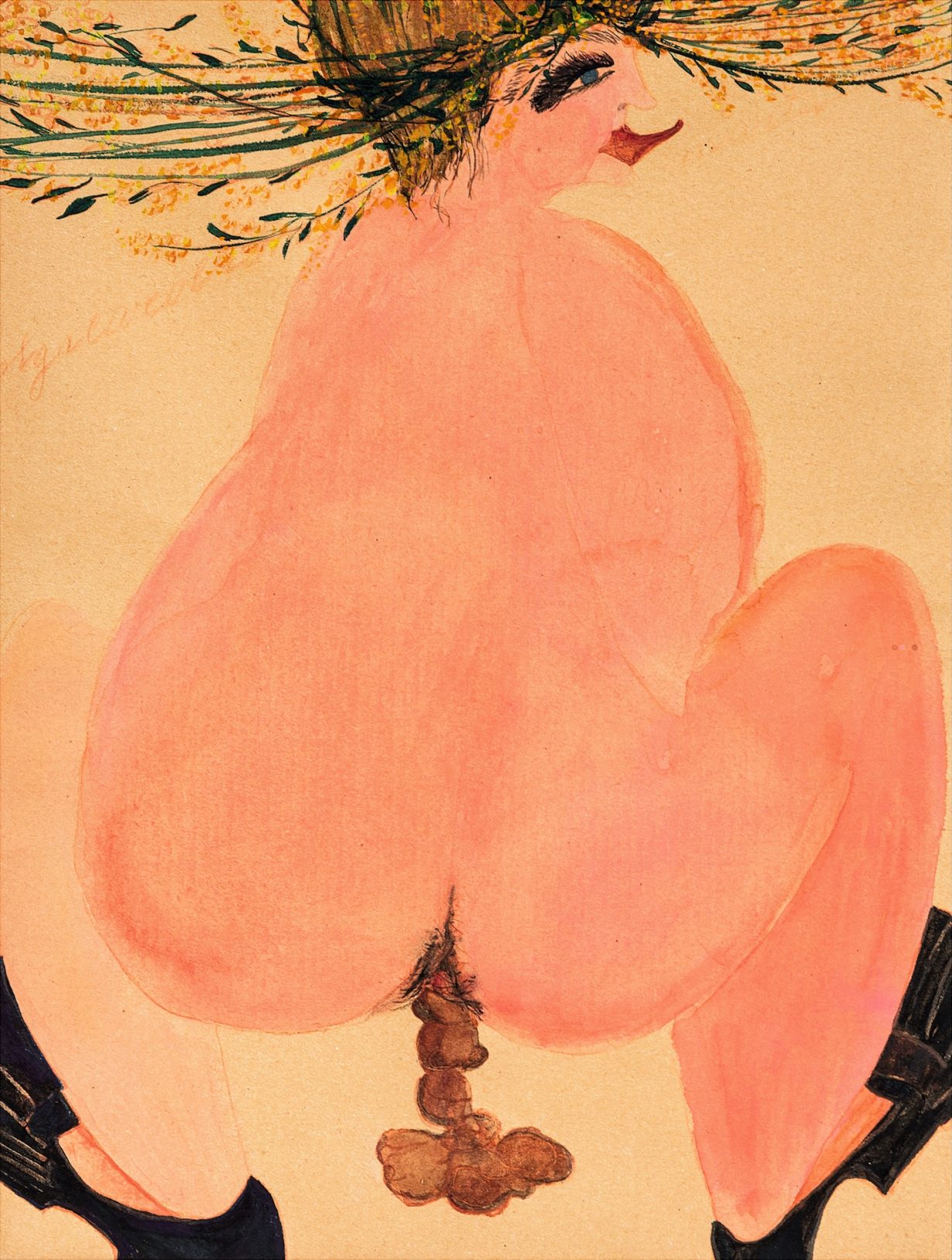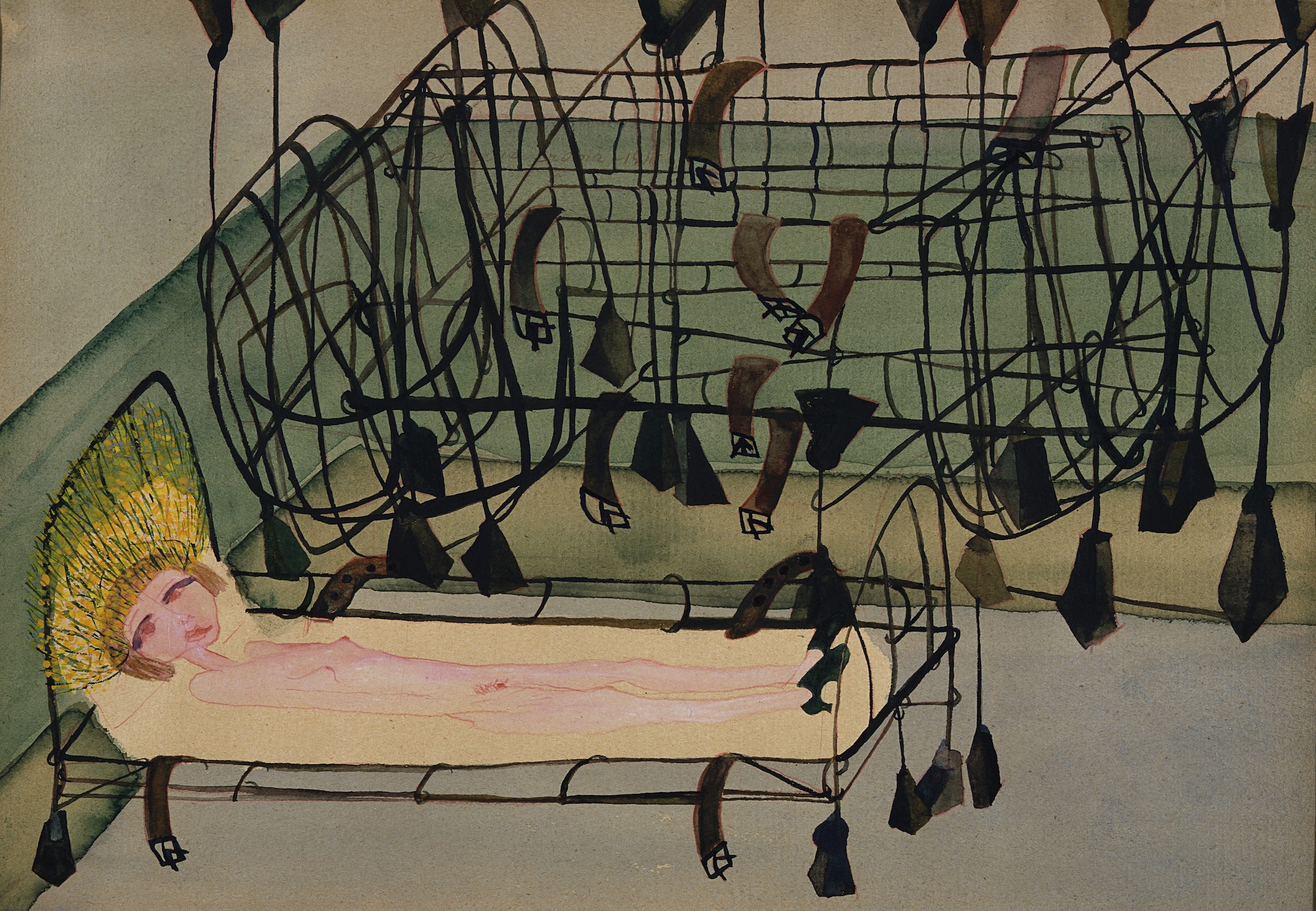Rama, who died in 2015, was snubbed by the artworld for decades. Now, at Kunstmuseum Bern, her grotesque, ungovernable iconography finds the limelight
Carol Rama died in 2015 at the age of ninety-seven, having been snubbed for many decades by the art establishment and then belatedly accepted into it. A Rebel of Modernity showcases the vicissitudes of the Turin-born artist’s career from the 1940s onwards and her periodic stylistic reinvention, following the formative watercolour series Appassionata (1936–46). Appassionata is equal parts grotesque and liberatory – Rama depicted women engaging in acts of defecation, exposing their orifices or contained within mental institutions – in pointed contrast to the message of control propagated by the Fascist government that governed Italy during most of its production. The exhibition subdivides 120 works into eight neat chronological ‘phases’: after ‘Appassionata’ comes ‘Anti-Portrait’ (1930s–40s), ‘Movimento Arte Concreta’ (1953–59), ‘Bricolage’ (1960–69), ‘Gomme’ (1970s) and finally the stylistic circularity of ‘Late Figuration’ (1980s–2015). It’s a timeline that naturally makes Rama’s iconographic programme legible, for all that her content is persistently ungovernable.
The exhibition puts Appassionata in the context of the mental decline of the artist’s parents: her mother’s institutionalisation, her father’s apparent suicide following the bankruptcy of his automobile business in 1942. The expressionistic, naive formal language of Rama’s works has an almost instructive instantaneity: the human form is minimised to a fleshy pink wash for skin and a reddened line for nipples, vulva and lips, delineated by a thin black line. In the Appassionata series, mechanisms of containment are humorously animated as the aggressors of institutionalised women: in Appassionata (1940), semi-phallic mechanical instruments appear in absurd quantities, suspended over a flaccid inpatient strapped to a hospital bed. In 1930–1931 Patent No. 7H126R (Appassionata) (1940), a limbless body is trapped within a chair whose wheels have multiplied – the figure is vulnerable, but her tongue leers outwards defiantly. Rama’s women are nonsubmissive: Marta (1940) squats, defecating; while Dorina (1941) lies on her back, prying open her rouge-coloured vagina.

A cross-temporal conversation between imagery is characteristic of the show. In Le Palette (1940), a series of garden shovels become vulvic, the base of each transformed with clearly outlined labia majora and minora. With Untitled (The Fur) (1954), Rama incorporates nonpainterly materials – placing lacerated faux fur onto hessian. Using rubber, she echoes earlier depictions of phallic tools and mechanical instruments as reproductive organs in her later ‘Gomme’ period; in Arsenale (1970), bicycle inner tubes are sliced open, flattened – their serial numbers still legible – and glued onto the canvas in thick swathes, their rust colour reminiscent of Titian’s flayed Marsyas.

In 1945, Rama’s first show – at Faber Gallery in Turin – was closed by police on grounds of obscenity. Since the 90s she has been welcomed into the canon, which A Rebel of Modernity cements through its particularised, formal categorisations of her work. Despite this genteel presentation, and the wide spectrum of her formal language, Rama’s dominant artistic impulse emerges with violence – her work is antithetical to containment. In the exhibition materials she is quoted speaking on the Autorattristatrice (1968–69) works (part of the ‘Bricolage’ series here) where singular taxidermic glass eyes punctuate nebulous black spraypainted forms. Subconsciously, perhaps, reversing Mussolini’s comment that ‘War is to a man what maternity is to a woman’, Rama offered this summa of her art: ‘I always had the need to create mutilation’.
A Rebel of Modernity at Kunstmuseum Bern, through 13 July
From the May 2025 issue of ArtReview – get your copy.
